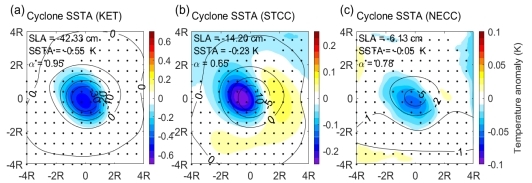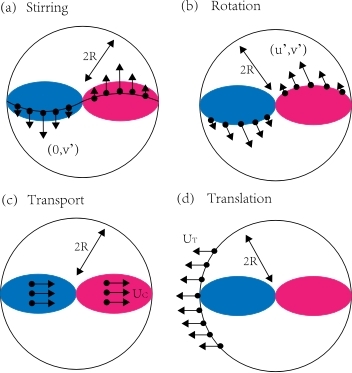How Do Eddies Drive Sea Surface Temperature Anomalies?
Mesoscale eddies are the primary source of mesoscale sea surface temperature (SST) variability, triggering mesoscale air-sea interaction and leaving rectification effects onto large-scale ocean circulations and climate systems.
Previous studies used composite method to obtain images of the intensity and structure of sea surface temperature anomalies (SSTAs) in different ocean regions. However, how eddies drive SSTAs remains an open question.
Recently, the research team led by Prof. WANG Fan from the Institute of Oceanology of the Chinese Academy of Sciences (IOCAS) provided new insight into the formation of structure of sea surface temperature anomaly induced by mesoscale eddies in the North Pacific.
The study was published in Journal of Geophysical Research: Oceans on Feb. 26.
Researchers used satellite data to analyze three regions of the North Pacific: the Kuroshio extension (KET), the subtropical countercurrent (STCC), and the North Equatorial Countercurrent (NECC). They found that eddy SSTAs present a monopole structure in KET and NECC region, and a dipole structure in STCC region.
Researchers suggest that lateral stirring acts as the major driver for eddy SSTA. Further, they independently constructed a simple model and isolate the effect of four processes: Stirring, Rotation, Transport and Translation. Stirring process produces strong dipole SSTA, while Rotation process rotates this dipole SSTA about 45 degrees and weakens its amplitude. Transport and Translation contribute to the formation of the monopole SSTA and further reduce the SSTA created by stirring.
By this model, the study found larger background SST gradient and eddy rotation speed favor large amplitude eddy SSTA. However, rapid mean current and eddy translation weakened the strength of eddy SSTA. Furthermore, mean current UC and eddy movement UT can greatly modify the SSTA structure when only the lateral stirring regime operates.
"The monopole SSTA in the NECC region results from both the fast westward UT and the strong eastward UC. By contrast, since both UC and UT are small in the STCC region, we observe dipole-like eddy SSTAs," said LV Mingkun, first author of the study.
"Many aspects of mesoscale eddies are poorly simulated in present climate models, leading to notable model biases. With this regard, this work provides a valuable benchmark for the evaluation of model capability in simulating the mesoscale SST variability for better predicting the future climate," said Prof. WANG.
"Since mesoscale eddies are ubiquitous in the world's ocean, the generation of monopole SSTA maybe at work universally in other regions with a large UC or UT. Dipole and monopole SSTAs may cause different flavors of surface turbulent heat flux anomalies, leading to diverse atmosphere-eddy feedbacks, and possibly further feedback on our climate," said Dr. LI Yuanlong, the corresponding author.
The research was supported by the Strategic Priority Research Program of Chinese Academy of Sciences, National Key R&D Program of China, National Natural Science Foundation of China, Shandong Provincial Natural Science Foundation, and the Key Deployment Project of CAS Centre for Ocean Mega-Science.

Fig. 1 Cyclonic eddy-induced SST anomalies in KET (a), STCC (b), and NECC (c)

Fig. 2 Schematic diagram of the four processes that form eddy SSTA. (a)stirring, (b) rotation, (c) transport, and (d) translation
Lv, M., Wang, F., Li, Y., Zhang, Z., Zhu, Y. (2022). Structure of Sea Surface Temperature Anomaly Induced by Mesoscale Eddies in the North Pacific Ocean. Journal of Geophysical Research: Oceans.
LI Yuanlong
Institute of Oceanology
E-mail: liyuanlong@qdio.ac.cn
(Editor: ZHANG Yiyi)